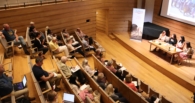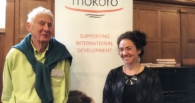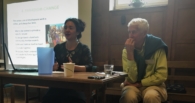Ethiopian Rural Communities: Where are they headed?”
A Mokoro Seminar
Alessa Rigal
18 January 2013
/
- 0 Comments
Mokoro started its series of 2013 seminars on an innovative note discussing the subject of “Ethiopian Rural Communities: Where are they headed?”. Many guests in attendance had spent a number of years living or working in Ethiopia (as academics, consultants, development practitioners), and others came with a genuine interest in the subject matter, all ready to discuss Mokoro’s research on the topic.
On 11 January, 2013 Mokoro’s Principal Consultants Catherine Dom and Becky Carter, members of the WIDE 3 research team, presented insights arising from the current stage reached in the research. The seminar was chaired by Dr. Sarah Vaughan, from the School of Social and Political Science at the University of Edinburgh. Since her involvement in humanitarian activities in the Horn of Africa in the late 1980s Sarah has researched and written on issues in Ethiopian political history for a range of organisations.
Since 2009 a Mokoro team together with Ethiopian researchers has been revisiting twenty villages that some of them visited for the first time in 1995. The team’s research is called WIDE 3: WIDE for Well-being and Ill-being Dynamics in Ethiopia, 3 as this is the third round of research in these 20 villages. In a rigorous case-based approach, this cross-sectoral research looks at the broad modernisation processes and outcomes in each community and documents how government and donor development interventions have interacted with these. The team aims to understand why processes of sustainable development seem to have taken off in some communities and less so in others, and on this basis, to offer hypotheses about where these ’exemplar’ communities – and other similar communities in Ethiopia – might be heading. The research draws on social science complexity approaches appropriate for the study of both long-term continuities and rapid change processes – two defining characteristics of the wider development trajectory of Ethiopia since the EPRDF-led government took over in 1991.
The WIDE research began with what is now known as WIDE1 in 1994 when fifteen village studies were launched in communities which had been selected by economists for an ‘Ethiopian Rural Household Survey’ (ERHS). The communities were chosen as exemplars of the main rural agricultural livelihood systems found in the four big Regions of Ethiopia at the time. In 2003 a second round of studies (WIDE2) was undertaken in the fifteen communities and simultaneously in three new agricultural sites, added to the panel by the ERHS economists in 1999 as exemplars of new agricultural livelihood systems, and two pastoralist sites.
In 2008 the team approached donors in Ethiopia with a proposal to re-visit the twenty communities over three stages to explore their longer-term trajectories and the contribution made to them by development interventions. Stage 1 lasted from November 2009 to August 2010 and covered the six communities about which the team had most information (three drought-prone and food-insecure and three self-sufficient). Stage 2 (August 2011 to January 2013) focused on eight drought-prone and food insecure sites. Stage 3, covering the remaining six rain-secure higher potential sites, is scheduled to take place from January to December 2013. CIDA, DFID and the Netherlands are funding the research through a World Bank managed Trust Fund.
Unlike many other ways of trying to track change and the effects of development interventions, this research focuses on cases rather than variables. Case analysis allows the team to identify major differences in the communities, which can then be used to inform and influence practical country sector policy planning and implementation. Each individual community is a complex entity, with different pasts, presents and futures, representing a trajectory. The team’s approach has been to identify the various key factors which are determining the direction of each community (called “control parameters” in complexity approaches). This is used to examine how these internal driving factors interact with external factors like development interventions and also broader modernisation processes and outcomes in the communities’ environments. This analysis, together with the tracking of change in each community from the first visits in 1995 to the fieldwork in 2009/10 and 2011/12 and a rigorous comparison across communities enables the team to document the extent to which each community has moved towards or temporarily beyond equilibrium, and the processes involved.
As the presenters described them, the villages are ‘evolving ecosystems, each self-organising but dynamic open social systems which have to respond to changes within the environments. At any given point, a community may be reproducing, changing structurally, heading for extinction or dithering’. The team also suggests that their understanding of what has happened and why to the WIDE communities might be relevant for other communities in Ethiopia that would be similar to these ‘exemplars’. This is what makes the research particularly relevant for policy-makers in Ethiopia.
The presentation focused first on four of the twenty communities, drawing on some of the research approaches and analyses used in the research. First, two most dissimilar communities were discussed: Harresaw in Eastern Tigray and Aze Debo’a in the Southern Region. Catherine compared their trajectories, focusing on how they have coped with the issue of the growing number of more educated youth seeking to establish independent livelihoods in today’s context of land scarcity and un(der)employment. Catherine explained how international illegal immigration emerged as a key option for the youth in both communities and briefly outlined its multifaceted implications for the communities’ possible futures. Secondly, Becky discussed two somewhat similar peri-urban communities, Shumsheha in Amhara Region and Adele Keke in Oromia. Her comparison focused on urbanisation and irrigation as key control parameters for these communities. Becky explained how regional planning and market linkages or lack thereof were shown to be critical in shaping urbanisation and irrigation experiences, with quite different features and effects in the two communities.
In a second part of the presentation, the focus turned to a few critical factors, discussing their presence, absence and effects across all fourteen communities studied so far in WIDE 3. For instance, the analysis of the case of internal paths, feeder roads, bridges and main roads highlighted the important differences in all fields of the communities’ development, arising from whether such infrastructure is in place or not. One of the points made was that while investment on main roads is critical and generally taking place, the presence and quality of internal and feeder roads, paths and bridges was equally critical to reduce otherwise significant differences in access to services and livelihood opportunities between areas in the communities. Yet this appeared to be an area in which the government expected that investment by the communities themselves would suffice.
The audience’s reactions made for a very lively discussion with the presenters, ranging across a number of topics. Migration and irrigation attracted a lot of attention. Related to irrigation, there were comments about its sustainability, and questions were raised about water and land rights and the relevance of the focus on agricultural inputs and improvement of productivity. It was highlighted that the issues of water and land rights, of further scarcity of land due to improved women’s rights and of differential access to irrigable land were critically important. Failure to resolve these issues transparently and fairly would be likely to lead to conflict across all areas where irrigation is being implemented and is possible, especially in these communities of which many had remained food insecure. It was said that in some cases, the development of irrigation as a private initiative had resulted in improved sustainability. However, the presenters highlighted that there also is a strong ‘public goods’ character in well-functioning irrigation schemes which have the potential of lifting up whole communities.
Concerning migration, it was clear that this was a fast-evolving phenomenon, already having a drastic effect in particular communities such as Harresaw, Aze Debo’a and others known by participants, and emerging in yet other areas of the country. Ethiopia has been a late-comer to this trend as compared with its neighbours Eritrea and Somalia which have had large and rising outmigration flows for many years. Migration is now prominent in policy discussions within governmental circles and among donors in Ethiopia. However, it is not yet clear whether the policy would tend to severely discourage those wanting to leaving or capitalise on the potential benefits of ‘safe migration’. There are indications that so far the former position might prevail. If the potential of migration is to be realised, a support system is needed for those who want to leave to engender more positive experiences while migrating and so that upon their return they are easily re-integrated into the society, bringing economic prosperity with them.
The seminar was a good opportunity for Mokoro to demonstrate the value of this work, which seeks to study and explain change in a way that hopefully brings insights complementing those from other research approaches undertaken by the Ethiopian policy-makers and their partners. The team is now turning to study the last six communities, all food secure, during the course of 2013.
You must be logged in to post a comment.



